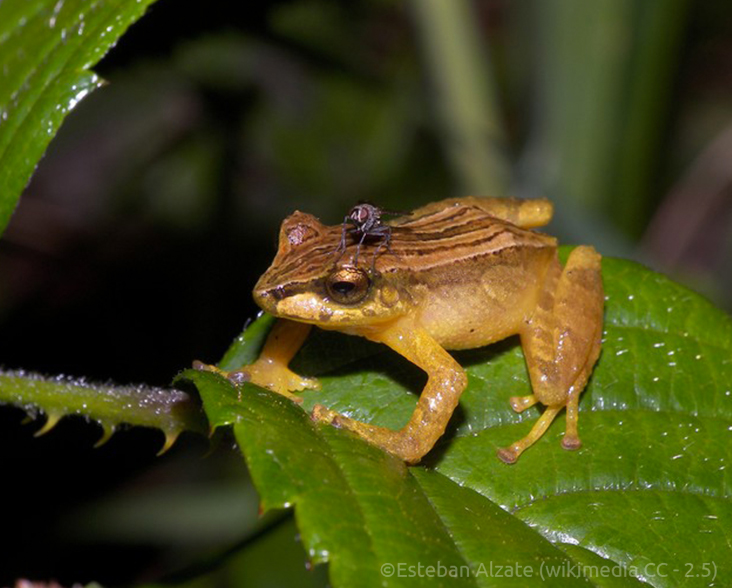Serna's Robber Frog
Species Data
Class: Amphibia
Order: Anura
Family: Strabomantidae
Scientific Name: Pristimantis dorsopictus
IUCN Red List status: Vulnerable
Description
The Serna’s Robber Frog is a small species, with adult females measuring 21.6-31.6 mm in length and males just 19-22 mm. The dorsal surface is highly polymorphic in colour and pattern, ranging from yellow to orange, with brown or black spots across the back, head and legs that sometimes join on the back to form longitudinal, transverse or oblique lines. The skin is smooth or finely granular and lacks dorsolateral folds. The ventral surface is unspotted, and males have a light yellow vocal sac. The clearly defined cream or white belly shows a white peritoneum membrane and a brownish medial line. The skin on the throat and chest is smooth but granular on the belly and thighs, and there is no webbing between the toes or fingers. The snout is short and subovoid, the tympanum is present and round, and the skin of the upper eyelid is covered in small granules with a central conical tubercle. The iris is reddish-orange with brown reticulations.
Behaviour
Almost nothing is known about the behaviour of the Serna’s Robber Frog. This species is active at night and more so in the wet season and on foggy nights. It the usually found in vegetation between 2-5 m above ground or in epiphytes. The song consists of a single high-pitched tick-like note. It is thought that this species does not produce free-living larvae but reproduces through direct development.


Habitat
The Serna’s Robber Frog is endemic to the north of the Central Cordillera of the Colombian Andes, where it inhabits the sub-páramo and montane forest between 2,400-3,000 m. It is not known from disturbed forest or human-modified habitats.
Threats and Conservation
This species is not well studied and is known only from three to five locations. The population is suspected to be declining due to ongoing habitat loss and fragmentation for agriculture, cattle ranching, and urban expansion. Further studies are required to identify the calls of this species to survey areas of possible occurrence. The Serna’s Robber Frog is listed as Vulnerable on the IUCN Red List.
This species occurs in several protected areas, including the Guanacas Reserve created in 1990 by WLT partner Fundación Guanacas Bosques de Niebla, which protects 520 ha (1,285 acres) of cloud forest, montane streams, and naturally regenerating pasture in the Andes of north-western Columbia. WLT is supporting a project by partner Fundación Guanacas Bosques de Niebla to expand the Guanacas Reserve and safeguard the habitat of the Serna’s Robber Frog.
